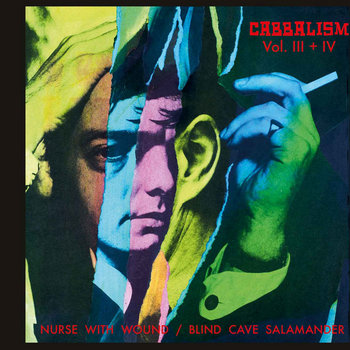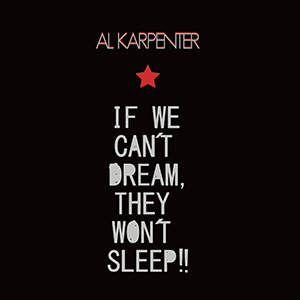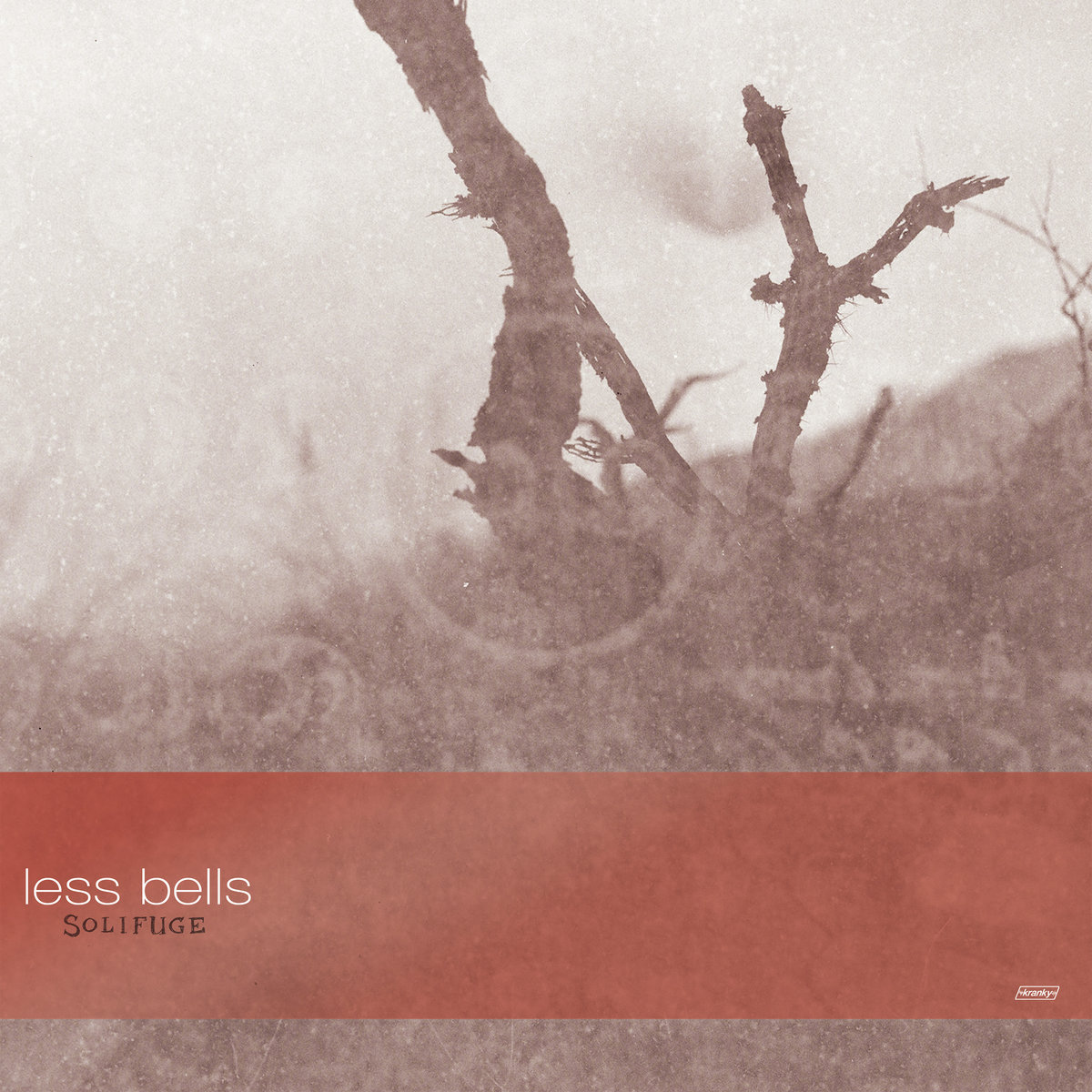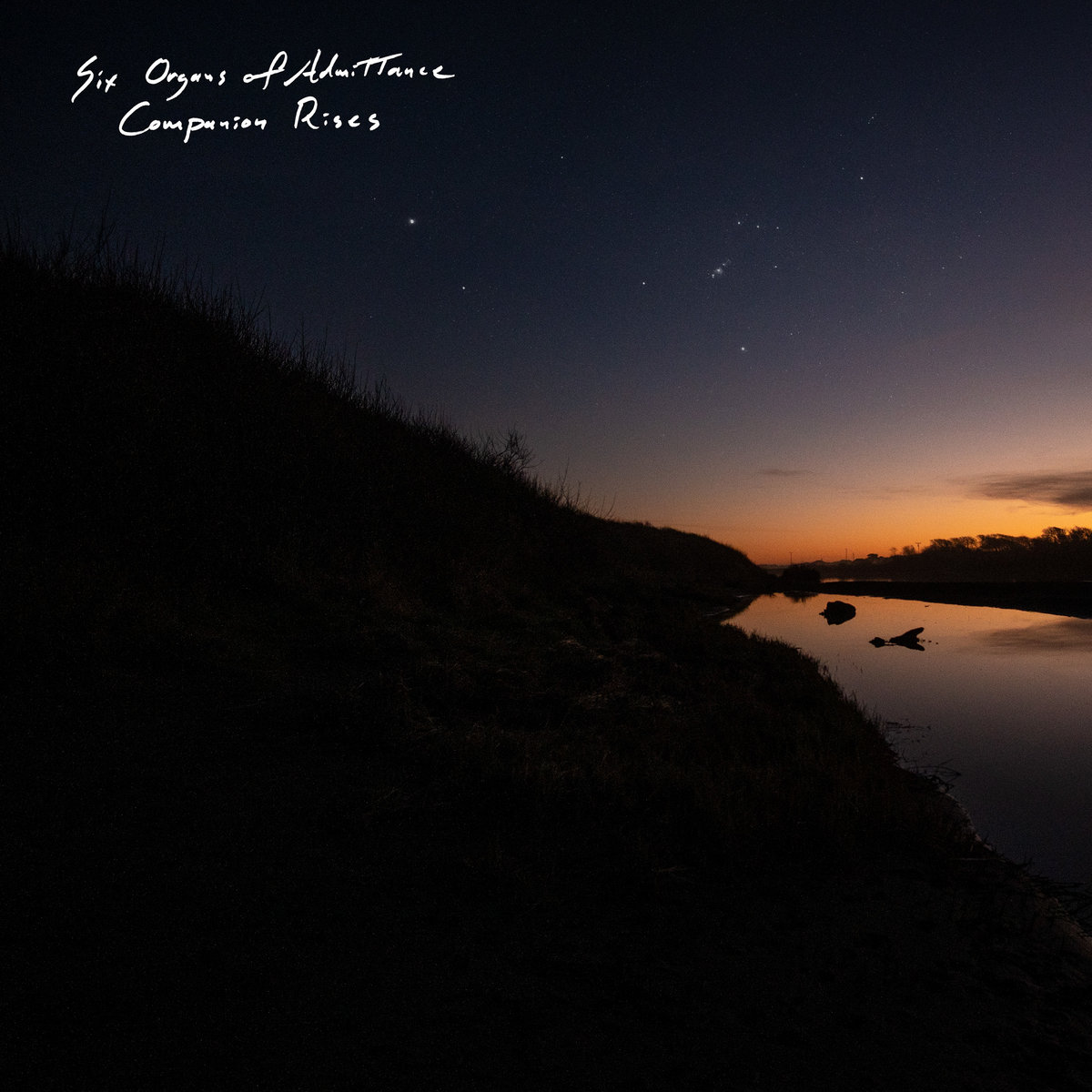- Administrator
- Albums and Singles

Originally released back in 1982 on Factory America, Ike Yard's debut full-length has been one of those rare records which rightfully lingers in the cultural consciousness as a very cool influence to reference, yet somehow remains perplexingly underheard. That is a damn shame and I hope this latest reissue from Superior Viaduct wakes some more people up to Ike Yard's incredibly forward-thinking moment of white-hot inspiration, as these NYC No Wavers deserve to be every bit as revered as their similarly out-of-step peers Suicide. Granted, Suicide definitely wrote better songs than Ike Yard, but Ike Yard were on an entirely different trip altogether and their aesthetic has aged beautifully in the ensuing four decades. In fact, if some Brooklyn band released this exact album today, I am positive that it would be all over "Best of 2020" lists and it would not be because of retro nostalgia: Ike Yard perfected their strain of tough yet arty minimalism so spectacularly that it still feels cutting edge today. Obviously, shades of this foursome's stark, bass-driven grooves can be found all over the darker, heavier side of contemporary techno, but that is not why this album deserves to be heard: it deserves to be heard because it still holds up as an absolutely killer album today.
The first time I heard this album (alternately known as A Fact A Second due to the cryptic cover art), I had a very hard time wrapping my head around the fact that Ike Yard was a full band rather than just one or two guys with some pedals, a drum machine, and a primitive sampler.Part of that is obviously due to the aggressively minimal nature of the music, as these six songs are so single-mindedly focused on the groove that everything else seems like an afterthought (I like to imagine that guitarist Michael Diekmann spent the bulk of his time during shows expectantly waiting to contribute a single string scrape or similarly non-musical bit of texture).Beyond that, however, it simply seems wildly improbable that four separate people could have possibly been on this same futuristic wavelength at once.It seems safe to say that Ike Yard were probably influenced by their contemporaries in the No Wave milieu and pioneering industrialists like Cabaret Voltaire, but those other artists feel self-consciously experimental in a way that Ike Yard does not: this album feels like an almost supernaturally assured artistic statement by a band that knew exactly what they wanted to do and executed that vision with surgical precision.These songs all feel chiseled to diamond-like perfection and deftly avoid anything that might feel dated, clumsy, derivative, or indulgent by today's standards (or any standard, really).Viewed uncharitably, one could argue that Ike Yard achieved that feat by simply excising just about everything that makes music feel like music.In particular, vocalist Stuart Argabright seems especially devoted to that approach, as his rare contributions consist entirely of a few lines of cryptic, deadpan spoken word.Somehow, however, that all suits the band's weirdly lurching and blurting robot funk perfectly.While other bands on Factory were awkwardly figuring out how white people could be plausibly funky, Ike Yard were already imagining what dance music might sound like in an entirely post-human world (and nailing it).
The centerpiece of the album (and probably of Ike Yard's career as well) is the tensely simmering second piece, "Loss."Over a stumbling off-kilter beat, percussive-sounding guitar harmonics, and a dubwise bass line, Argabright blankly delivers a monologue that fades in and out of focus amidst fitful snare eruptions and chopped, sputtering squalls of sampled voices.I am especially fond of the chopped voices, as it sounds like a strangled radio transmission is constantly threatening to overpower the song, yet keeps disintegrating before it can succeed.The other five songs could have probably benefited from a similar twist, but in general the grooves are muscular and alien enough to hold up without any kind of leftfield stab at a "hook."The opening "M. Kurtz" fares especially well in that regard, as its shambling rhythm feels simultaneously ridiculous and brilliant, as it calls to mind a cartoon tuba jamming with a broken, disjointed drum machine pattern.Despite that unpromising foundation, the addition of Argabright's mumbled vocals and Kenny Compton's insistent bass line somehow transform those seemingly disparate parts into something that seems weirdly cool and purposeful.My other favorite piece on the album is "Kino," but the only real difference between the better pieces on the album and the more forgettable ones is merely the degree to which the band flesh out their skittering and stumbling grooves."Kino" features some moaning, atmospheric guitars; other songs are essentially just bass, drum machine, and mumbled vocals.To Ike Yard's eternal credit, however, that machine-like repetition coupled with splashes of snare drum violence is usually enough to make a compelling song, even if the band seemed to have an almost willfully self-sabotaging approach to rhythm: aside from "NCR," every single song feels like a deliberate attempt to conjure up a groove so erratic, bizarre, and awkward that non-spasmodic dancing is nearly impossible.  
Lamentably, Ike Yard broke up in 1983 before they got a chance to record a second album, which actually seems entirely appropriate to me: after distilling post-punk to its most muscular and stark extreme, it is hard to imagine where they could have gone next.Also of note: being this crazily far ahead of the curve tends to be financially ruinous, though the band must have had a significant enough following to attract the attention of Factory (Ike Yard was their first American signing).There is a happy ending though, as more than two decades later, three-fourths of the original band reformed for a considerably more prolific second act (including several remix EPs featuring fans like Regis and Tropic of Cancer).Nevertheless, this original full-length still calls to mind the famous Brian Eno quote about The Velvet Underground & Nico (not many people bought that album, but the few who did all started bands of their own).It also improbably reminds me of a review I once read of Prong's impressively ugly Beg to Differ that proclaimed that it sounded like a scarier version of Metallica that got into beer bottle-eating contests with skinheads.Thankfully, Ike Yard sounds nothing like any era of Metallica, but this album begs a similar analogy: this is what Jamaican dub would probably sound like if it had emerged from a bombed-out, post-apocalyptic squat in Berlin rather than sunny Kingston.It may not be a perfect album, as its hookless monochromatic minimalism inherently makes all the songs sound similar to one another, but none of that matters because the aesthetic itself is so singular and wonderful.Few albums deserve a high-profile reissue and a chance at a second life as much as this one.
Samples can be found here.
Read More
- Administrator
- Albums and Singles
 Much like everyone else with a deep interest in experimental music, I have spent a good amount of time exploring the more avant-garde side of 20th century classical music. Estonian composer Arvo Pärt is admittedly not an artist who fits particularly comfortably in that milieu, as he took a far more unique and anachronistic path than most of his peers and embraced Gregorian chants and simple melodicism rather than dissonance, conceptual art, complicated harmonies, electronics, or Eastern drones. That path has rightfully made him one of the most frequently performed contemporary composers, but his work did not make a deep impact on me until I heard the sublime "Spiegel im Spiegel" in Gus van Zant's similarly sublime Gerry. After that revelatory experience, I immediately dove headlong into Pärt's classic ECM albums and they have been a fixture in my life ever since, but I was completely unaware of this album (originally released on the German label Beaux in 2001). Now that it has been reissued, I can see why these pieces did not initially make the same cultural impact as some of Pärt's other work, but I can also see why they eventually found an audience regardless: Works for Choir feels like a dispatch from an alternate timeline in which Bach was never shouldered aside by folks like Schoenberg and Stravinsky and simple beauty never fell out of favor.
Much like everyone else with a deep interest in experimental music, I have spent a good amount of time exploring the more avant-garde side of 20th century classical music. Estonian composer Arvo Pärt is admittedly not an artist who fits particularly comfortably in that milieu, as he took a far more unique and anachronistic path than most of his peers and embraced Gregorian chants and simple melodicism rather than dissonance, conceptual art, complicated harmonies, electronics, or Eastern drones. That path has rightfully made him one of the most frequently performed contemporary composers, but his work did not make a deep impact on me until I heard the sublime "Spiegel im Spiegel" in Gus van Zant's similarly sublime Gerry. After that revelatory experience, I immediately dove headlong into Pärt's classic ECM albums and they have been a fixture in my life ever since, but I was completely unaware of this album (originally released on the German label Beaux in 2001). Now that it has been reissued, I can see why these pieces did not initially make the same cultural impact as some of Pärt's other work, but I can also see why they eventually found an audience regardless: Works for Choir feels like a dispatch from an alternate timeline in which Bach was never shouldered aside by folks like Schoenberg and Stravinsky and simple beauty never fell out of favor.
While he certainly evolved into an iconoclastic composer by the time he reached middle age, it is worth noting that Pärt did not instantly burst onto the scene with a fully formed aesthetic of his own and mostly spent his early years in the thrall of the usual classical influences.I say "mostly" because Pärt's native Estonia was controlled by the Soviet Union for much of his life, which made it difficult to acquire music that was not government-approved.In fact, Pärt's own early twelve-tone-inspired works were themselves banned by Soviet censors, triggering both a deep depression and "the first of several periods of contemplative silence, during which he studied choral music from the 14th to 16th centuries."Eventually he started composing again, but after finishing his Third Symphony (1971), he started looking even further back for inspiration, immersing himself deeply in early religious music like plainsong and Gregorian chant.Unfortunately, the Soviet authorities were not fond of his religious-themed work from this period either, so his problems and frustrations continued.Happily, however, the Arvo Pärt that we all know and love reinvented himself and re-emerged to enter his most fruitful creative period in the late 1970s, as many of his best-loved and most influential works were composed during a single stretch when he was in his early forties.That chronology is interesting because the more overtly conventional pieces collected on Works for Choir date from roughly a decade later (1988 -1991).In some ways, that curious progression makes sense, as Pärt's trajectory seems to have been one leading to greater heights of both religiosity and simplicity, yet he still remained a deeply adventurous composer in his compositional techniques.
For the most part, almost none of these eleven pieces would result in a raised eyebrow if they turned up in a Christian mass (Pärt converted to Orthodox Christianity in the early 1970s), though the opening "The Beatitudes" does feel unusually intense and bracing for such fare.Part of that is due to the almost darkly psychedelic organ finale, but there are also several unusual compositional tricks at work before that point.The text of the piece (in English) is taken from The Sermon on the Mount, but Pärt emphasized passages by writing each "each clause…in a different harmonic key" while "the central pitch of the recitation constantly rises, increasing the tension."Then, after the crescendo, the same process unfolds in reverse.All of the album's other major stand-alone pieces follow soon after, though "Magnificat" and "Nun eile ich zu euch" seem to hew fairly closely to the expected Christian choral tradition.Both are, of course, quite beautiful.They just are not particularly radical.I suppose "Summa" is not all that overtly radical either, but is an achingly gorgeous album highlight with an intriguing history.According to the original CD, the piece dates from 1990, but the choral version that appears here actually dates back from Pärt's late ‘70s heyday.He has since repurposed the piece several times as an instrumental work, however, which makes sense: its lyrical basis in the Latin Credo would not have been acceptable to Soviet censors, so Pärt gave it both a title that "hides a coded message" and a circular structure that "conveys a symbolic meaning."The remainder of the album is devoted to a series of shorter pieces that collectively form "Sieben Magnificat – Antiphonen," a collection of prayers (in German) composed in Pärt’s signature tintinnabuli style.While intended as a seven-part whole, the various sections were designed to contrast each other various ways, so it is not uncommon for individual sections to be performed by themselves.
Sadly, my grasp of early religious music and Pärt's compositional intricacies is not quite deep enough for me to fully appreciate the various innovations lurking in the structure of these pieces, nor am I sufficiently versed in Christianity to grasp the deeper meaning of the texts Pärt chose.As such, Works for Choir does not feel nearly as singular or subversive as it might seem to a classical music scholar.Instead, it feels like excerpts from an especially good religious mass composed in an earlier time, which is just fine by me.It almost makes me nostalgic for a less secular era: while the old adage that the devil gets all the good music certainly has some truth to it, it is equally true that a passionate belief in a higher power has inspired quite a lot of towering masterpieces of both music and architecture over the years.It is certainly hard to imagine either Simon Finn or David Tibet reaching their most fiery heights without some kind of spiritual drive behind them and the same is true of Pärt.While Works for Choir does not disabuse me of my firm belief that Pärt reached his creative zenith in the late '70s, my only real issue with this album is that it blurs together with the work of other composers in a way that his finest work does not.Within the context of Pärt's oeuvre, these pieces are more significant as a document of his evolution than as a crucial album, though I would certainly feel comfortable including "Summa" and "The Beatitudes" among his landmark works.Within the context of classical music as a whole, however, Works for Choir is a strong collection that scratches roughly the same itch as a Bach mass or the better work from Pärt's fellow holy/mystic minimalists like Tavener or Górecki.
Samples can be found here.
Read More
- Administrator
- Albums and Singles

Cabbalism III (Leuven) was originally released as a limited edition. NWW always felt that this recording was the best of the 3 "Cabbalism" shows & over the years many people have complained of its unavailabilty, so here it is, with the addition of an extra track - "Cabbalism IV." This was made by Colin Potter using sources from all three "Cabbalism" recordings, mixed and mastered at IC Studio, London 2020.
Steven Stapleton - Guitar & effects pedals
Colin Potter - Electronics, mix
Paul Beauchamp - Electronics, musical saw
Julia Kent - Cello
Fabrizio Modenese Palumbo - Guitar, electric viola
More information can be found here.
Read More
- Administrator
- Albums and Singles

"Ian Masters and Warren Defever working together as ESP Summer. More coming soon."
More information can be found here.
Read More
- Administrator
- Albums and Singles

Midwife has released a split cassette with M. Trecka.
Side A. "In Ellipsis Landscapes" Mark Trecka in collaboration Susan Alcorn 17:20
Side B. "Heaven" - Midwife in collaboration with Amulets 16:46
"I recorded it before I wrote anything for Forever; it acts as a kind of prologue to the record in my mind." -Madeline Johnston
More information can be found here.
Read More
- Administrator
- Albums and Singles
 FACS, spawned from the ashes of Chicago’s Disappears, display a certain homage to early Public Image Limited paired with a reverence to Fugazi on their latest album, but visualize a version of both, pressed through a sieve of muted sonics and disaffected resignation. Void Moments finds FACS’ musical sound experimentation greatly expanded beyond their prior output. With a finely crafted blend of bleak minimalism, dark noise, and energizing rhythms, this work takes all the energy of recent experiments, honing the melodies into a deeper, darker, and richer menace of beauty and power.
FACS, spawned from the ashes of Chicago’s Disappears, display a certain homage to early Public Image Limited paired with a reverence to Fugazi on their latest album, but visualize a version of both, pressed through a sieve of muted sonics and disaffected resignation. Void Moments finds FACS’ musical sound experimentation greatly expanded beyond their prior output. With a finely crafted blend of bleak minimalism, dark noise, and energizing rhythms, this work takes all the energy of recent experiments, honing the melodies into a deeper, darker, and richer menace of beauty and power.
The album kicks off with "Boy," deceptively sounding like a simple take on nineties noisy post-rock, until about halfway when the sonic meatiness starts to engage. This merges nicely into "Teenage Hive" at which point the true flavor of the album starts to reveal itself. Noah Leger’s drumming doesn’t attempt to 100% match up with the rest of the instruments, creating an unease coated by a thick layer of discordant guitars, Brian Case’s disenchanted vocals mired in the mix.
There is a sense of "void moments" throughout the record, as if meant to echo a sense of erased time in 2020, and Case vocalizes his disapproval, with the rest of the group displaying their displeasure through a controlled discord. "Lifelike" starts off on an industrial footing with the repeated crunch of distorted guitar, haunted by accents of atmospheric electronics, then launching into a chaotic flurry of Leger’s drums, the void driven home by Alianna Kalaba’s deep bass delay.
Closing track "Dub Over" is probably the most ominous thing I've heard in months, positively crying out for resolution, an escape from claustrophobic spaces. It builds from an atmospheric gothic foundation of muted guitar and distant, ethereal electronics, driven by a cold, staggered drum beat before being overshadowed by modulated vocals and wailing guitars before the guitar is left to sustain into nothingness. FACS often use the space between sounds to invoke emotion, and the space of void is echoed lyrically: "Are you sure truth is space between words / can you be sure it’s what you want?"
Void Moments was engineered by the illustrious Sanford Parker, who has lent his touch to a wide array of artists spanning multiple genres—noise, post-punk, death rock, industrial, doom, metal, dark ambient and others—as well as being an active producer and musician, both solo and in other projects. Sanford is a master at capturing bands at their most visceral and raw, and his work here is no exception. At the closure of "Version," a track sounding much like a deliberate and chaotic replicate of an already zoned and drawn-out Morphine track, one of the band’s members can be heard excitedly inquiring "Sanford, did you record that?" Clearly he did, with all the bands rawness captured for posterity.
Read More
- Administrator
- Albums and Singles
 Al Karpenter’s debut album is one of those that feels perfectly aligned with the present day. With performers hailing from the Basque region of Spain, Japan, and Berlin, the entire world’s state of disarray is fully represented in the broken electronics, erratic garage rock, and full on unhinged punk styles. It is entirely unpredictable: a massively disparate backing band supporting Karpenter’s erratic, rambling vocal style that is a ceaseless mix of frustration, paranoia, and anger, but it all makes sense and—while it may not be a casual experience—it is a gripping one.
Al Karpenter’s debut album is one of those that feels perfectly aligned with the present day. With performers hailing from the Basque region of Spain, Japan, and Berlin, the entire world’s state of disarray is fully represented in the broken electronics, erratic garage rock, and full on unhinged punk styles. It is entirely unpredictable: a massively disparate backing band supporting Karpenter’s erratic, rambling vocal style that is a ceaseless mix of frustration, paranoia, and anger, but it all makes sense and—while it may not be a casual experience—it is a gripping one.
Karpenter and crew: a backing band made up of Bilbao, Spain’s preeminent experimenters (Mattin, Joxean Rivas, and María Seco), early Fushitsusha drummer Seijiro Murayama, Lucio Capece, and Chie Mukai waste no time in getting weird.Right from the onset, the opening title song is all massive bass, garage guitars, and erratic drum machine loops.With some shifting tempos and intentionally jarring stop/start moments, there is an endearing, and intentional sloppiness throughout.Later on, the crew transition things to more menacing spaces, with Karpenter's megaphone like vocals and shrill electronics giving a greater heft to the proceedings.
That psychedelic tinged garage punk vibe is probably the most consistent thing on here, and is also prominently featured on "Sing the Battle Hymn!" as well.Fading in with a lofi 60s rock mood, it quickly erupts into full automatic drumming and broken guitar squalls.On "No Face" a similar guitar sound bursts out here and there, but in this case it is more of an added flavoring to dreary improvised percussion and elongated strings by Mukai, making for one of the few meditative moments on this otherwise blasting record.
Other songs on If We Can't Dream, They Won't Sleep! lean a bit more into the electronic end of the spectrum.With Karpenter's voice and Mattin's electronics leading the way, the subterranean bass and skittering cymbals, "Pow'r" resembles an extremely bastardized take on Miami Bass.That is at least until the jazzy sax of Capece and improvised percussion from Rivas and Murayama shift into focus.Even with Karpenter’s spoken word and rigid rhythms, album closer "Riot & Roll!!" is another electronics heavy piece of sputtering rhythms and synths, bass guitar, rigid rhythms, and Karpenter's far off frustrated yelling.
For me, the high water mark of the album is the side one ending "If They Sleep…" The up front drumming and jazz-laden outbursts with Karpenter's bizarre re-interpretation of the Stooges’ 1969, lyrically updated for 2019, capture frustration and disgust perfectly.Samples, surging electronics, and a multitude of rhythms intertwine for something that feels simultaneously spontaneous and composed.For its entire shambolic opening, however, the second half makes for an accurate reading of free fusion jazz with just the right amount of noise and absurdity to be had.
As a debut, Al Karpenter's If We Can’t Dream, They Won’t Sleep!! is certainly a difficult one to categorize.At times sounding completely unhinged and random, and at others something that is actually carefully planned and structured, it is challenging to say the least.But regardless, he and his backing band use this to create such an amazing sense of tension, frustration, and confusion that just makes perfect sense.With some pure strain psychedelic guitar workouts and noise outbursts that add a sense of both terror and fun, the album is sprawling and all over the place, yet given how 2020 has been thus far (and is likely to continue), it is the perfect sound for the times.
Read More
- Administrator
- Albums and Singles

All music has varying levels of emotional intensity, but some music is made just for this purpose. Hence the debut from Less Bells, the ethereal project of violinist/composer Julie Carpenter. Inspired by the desert sparseness of Joshua Tree, Solifuge — a word derived from "Solitude" and "Refuge" — is a lush neoclassical work crafted with a wide array of both electronic and acoustic instruments, resulting in an ambient journey that is unexpectedly not as meditative as the description suggests.
Less can be more, and a weaving of violin, cello, voice and synth (and yes, bells) supply that concept, providing an abundant orchestral soundscape that serves to draw in listeners with subtlety rather than salience. Having scored for a surprising number of TV series and documentaries, Carpenter understands how to best match sound with image to reinforce a story. This background is reinforced on Solifuge, a title that also refers to "sun spiders" or "wind scorpions" of the class Arachnida and found mostly in desert climates. The cover sports a photo representing the dryness of such a climate, and is mirrored by song titles such as "Desert" and "Golden Storm." Either interpretation of the album's title may, or may not, be what the artist intended, but the beauty of any good story is in open interpretation by the reader.
When I have taken long drives through the southwestern United States, I find my journey is two-fold. There are times when I don't pay much attention to the landscape, instead viewing it as a seemingly non-stop barren landscape through which to pass through. At other times, I have paused to truly take in the beauty of the teeming, yet often concealed wildlife, a subdued landscape that belies the assortment of wild, untamed flora and fauna within. Such a two-sided analogy is perfect for the sounds within; a complacent and gentle intimacy of that environment is evident about halfway through the album before it takes a wilder turn. Gentle effects make way for unnerving atonal experimentation. The layers of this work make it incredibly suited for vinyl.
Carpenter has commented that many of the compositions on Solifuge are "inspired by August monsoons rolling in over the mountains, others by clear, starry nights." Her grasp of compositional elements provide a rollercoaster of emotions: a fading cello that leaves a feeling of emptiness ("Desert") contrasted with a mood of joyful wonder ("Golden Storm"). "Milwaukee Protocol" is the longest track on the album, affording it time to build towards a sense of dread and dissonance from serene beginnings, becoming claustrophobic before beckoning a sweet release at the end. The musical journey is controlled with her mastery of composition, like a magician conjuring up an illusionary landscape, leading the traveler to an unknown destination while still allowing space to wander and get lost.
Read More
- Administrator
- Albums and Singles

When I first encountered Six Organs of Admittance some time in the early '00s, the bits and pieces I heard were scattered across different college stations, smothered by a popular glut of what I categorize—unfairly or not—"folk hipster wannabes." Consequently, the work Ben Chasny was doing became lost on me, choosing to turn my attention instead to more experimental drone and krautrock, two genres I viewed as mutually exclusive from folk. I had long been into psychedelic rock in the vein of Jefferson Airplane, but it wasn’t until I ventured into English folk like Pentangle and Fairport Convention in the '10s that I was pushed towards the psychedelic folk leanings of Roy Harper, John Fahey, and Sandy Bull. From there, it was easy to fall into a rabbit hole of amazing fingerpick guitarists, but the field of guitarists taking it deep into experimental sonic territory was sparse at best.
Fast forward to 2020, and I am kicking myself for skipping Six Organs all those years. Nonetheless, I am beyond happy to be more intimately introduced starting with this one, which takes all of the great guitar sounds I became obsessed with, and smashes them together into an extraordinary sonic synthesis of acoustics, noise and drone. Chasny’s melodic and organic guitar work, ever present at the forefront, is enriched with added metaphysical imagery, sonic distortion, and synthetic ambience blending the musical palette to create pieces that are as invigorating as they are meditative. While loops and sound processing are abundant, they serve to enhance the emotive power of the songs, even on the occasion the sounds drown the uppermost layer of Chasny’s guitar. As an example, track "Black Tea" begins with rolling acoustic chords, becoming offset by echo and modulation, amping up the gloomy atmosphere as the phrase "I can barely move" is repeated.
Companion Rises retains the "psychedelic folk" moniker by beguiling the earbuds with a commanding acoustic cocktail, but bears plenty of sonic resonance to destroy the definition. "The 101" rocks out, a blur of noise and fuzz with vocals drawn back into the mix, but the electric guitar is never missed as it ends up monopolizing the song with a herculean solo that results in a potent finish. Standout track "Haunted and Known" kicks off with a gentle and passionate acoustic refrain that melts into waves of distortion, changing the gentle refrain into a melody of unease and wonder.
Chasny states the lyrics on Companion Rises relate to the stars. The cover shows a view of the sky at the last moments of sunset. Could the companion that rises be the night to our day, the dark to our light? If so, then the album seems to suggest that this companion is not all bad. The album settles into a gentle closure with the ambient piece "Worn Down to the Light," suggesting an ethereal—if not concrete—answer to that question.
Read More
- Administrator
- Albums and Singles

Seminal British experimental musician Richard Skelton joins Phantom Limb for the release of stunning new album These Charms May Be Sung Over A Wound, his first for the label, first on vinyl in over a decade, and a standout record in his own catalogue.
Over the past sixteen years, Richard Skelton has developed a signature sound, often comprised of strings, piano and other acoustic instrumentation. Since 2013 he has increasingly buried these organic sources in layers of detritus and static. The process, as he articulates it, is to use signal-degradation as a means of reflecting the processes of decay and transformation in the natural world. His music has been placed alongside giants of experimental music, such as Brian Eno, Harold Budd, Stars Of The Lid, William Basinski.
With new album These Charms May Be Sung Over A Wound, however, Skelton has abandoned acoustic instrumentation altogether to map out a new territory of buzzing sine tones and square waves, immersed in shimmering clouds of distortion and suspended over landscapes of thrumming bass. The result is a new and transcendental experience: while the key themes of Skelton's music remain - stark and lonely geographies, ancient myths buried deep within the land, slow-moving glacial evolution - we are transported to a darker and more mechanical place. The intensity and sound design here are more akin to quasi-industrial, abandoned-factory sonics than to earthy, organic tones of earlier Richard Skelton albums. Abul Mogard and Alessandro Cortini could be considered peers now, just as much as Eno and Basinski had been before.
Out September 25, 2020. More information can be found here.
Read More
- Administrator
- Albums and Singles
 This latest volume of Carsten Nicolai's planned five-part series devoted to degraded samples is a bit different from previous installments, as the Xerrox vision has become a more focused and cinematic one. In Nicolai's own words, this series has increasingly been devoted to exploring more "intimate gestures and emotional sensibilities" than the meticulous sound design perfectionism and concept-driven art that he is best known for. In practical terms, that means that Xerrox, Vol. 4 mostly captures Alva Noto in comparatively abstract and almost "ambient" territory, as these fourteen songs are uncharacteristically built from slow-moving drones and sleepy, soft-focus melodies. For the most part, such an approach is appealing primarily because it reveals a more organic and harmony-focused side to Nicolai's long-running and oft-excellent project (as opposed to an evolution or improvement upon his usual fare). As such, Xerrox, Vol. 4 is a definite outlier in the Alva Noto discography. In the case of few pieces, however, a more gnarled and dissonant character unexpectedly emerges that feels like a tantalizing glimpse of a significant creative breakthrough.
This latest volume of Carsten Nicolai's planned five-part series devoted to degraded samples is a bit different from previous installments, as the Xerrox vision has become a more focused and cinematic one. In Nicolai's own words, this series has increasingly been devoted to exploring more "intimate gestures and emotional sensibilities" than the meticulous sound design perfectionism and concept-driven art that he is best known for. In practical terms, that means that Xerrox, Vol. 4 mostly captures Alva Noto in comparatively abstract and almost "ambient" territory, as these fourteen songs are uncharacteristically built from slow-moving drones and sleepy, soft-focus melodies. For the most part, such an approach is appealing primarily because it reveals a more organic and harmony-focused side to Nicolai's long-running and oft-excellent project (as opposed to an evolution or improvement upon his usual fare). As such, Xerrox, Vol. 4 is a definite outlier in the Alva Noto discography. In the case of few pieces, however, a more gnarled and dissonant character unexpectedly emerges that feels like a tantalizing glimpse of a significant creative breakthrough.
The album opens with one of Nicolai's strongest and most evocative feats of sample-layering alchemy, as "Xerrox Kirlian" combines somber synth chords, twinkling chimes, strings, ghostly voices, and a rumbling undercurrent of noise into a tender and bittersweetly melancholy dreamscape.To some degree, that piece sets the tone for the entire album and it is generally an appealing one, but the album tends to reach its greatest heights when Nicolai heads in a more sci-fi-influenced direction.His occasional forays into harsher textures are quite welcome as well, as they inject some very effective bite and dynamic intensity into the album's understated, grayscale aesthetic.For the most part, however, Xerrox, Vol. 4 makes me feel like I am walking slowly through the ruins of an abandoned city in a daze.In fact, the album almost feels like a futuristic field recording of empty, windswept streets and blowing trash, but one that is haunted by an omnipresent, machinelike-hum and drifting, curdled strains of orchestral music.While that certainly makes for a brooding and sustained atmosphere of ominousness, Nicolai is generally quite content to simply let that air of mystery and emptiness linger, only rarely parting the veil to reveal something more substantial and structured.The most vividly realized and memorable of those moments falls near the end of the album, as "Xerrox Sans Retour" builds up from a ghostly chord progression into an eerie crescendo of bleary strings, scrapes, and crackles.There are several other pieces in which form breaks through the fog, however, and they all seem to reveal a different shade of the same desolate reverie (sometimes even letting in an unexpected bit of light).  
Most of the lighter pieces appear on the first half of the album, such as "Xerrox Neige" and "Xerrox Île."The former is essentially a drone piece, but the lazily undulating tones feel considerably warmer and more organic than those that fill the rest of the album (even the rhythmic washes of crackling static feel non-threatening)."Xerrox Île," on the other hand, is one of the album's more melodic pieces, as a lovely, Celer-style string loop lazily floats across a stark landscape of distant rumble and hiss.Elsewhere, "Xerrox Voyage" takes a sleepily wistful tone, as an understated and gently twinkling melody unfolds over a corroded-sounding backdrop of deep-bass drones and spacey textures that resemble interstellar radio signals.Later, the album's longest piece ("Xerrox Calypsoid 2") explores similar territory, but heads in a more ambiguous and queasily hallucinatory direction, as Nicolai's slow-motion string samples descend in a disorienting and vaguely dissonant chord progression.I prefer the shorter "Xerrox Calypsoid 1" though, as it is enlivened with a host of buzzing, whooshing, and sputtering textures that give it a bit more textural heft.That said, the album's highlights are not all that different from the rest of the songs, as Nicolai remains unwaveringly devoted to an elusive aesthetic of hazy, slow-motion melodies over shifting sands of bleakly eviscerated-sounding drones.The overall effect feels akin to being submerged existentially, like there is some kind of barrier dampening and blurring every stimuli.      
It feels somewhat wrong to describe Xerrox, Vol. 4 as a challenging or difficult album, as I usually reserve those terms for harsh or radically structured work.This album, on the other hand, is consistently tranquil in tone and relatively conventional melodically, yet it feels fundamentally alienating and unsatisfying by design.That admittedly seems like a perplexing choice, but given how exacting Nicolai's work has been in the past, it can only have been a very deliberate decision.While that approach is not necessarily ideal from an entertainment perspective, Nicolai has always been a very cerebral and art-driven fellow and Xerrox, Vol. 4 is nevertheless an intriguing and ambitiously unusual statement that may very well be ahead of its time.In fact, it could be argued that he has birthed a new type of science fiction dystopia with this album, as it feels like the soundtrack for a future that is washed-out, crumbling, and numb rather than one populated with flying cars and glittering skylines of shiny metal edifices in unusual shapes.Actually, in keeping with Nicolai's compositional approach, it might be more apt to say it feels like a grainy, tenth generation photocopy of a futuristic city that has rendered everything a lifeless, murky gray.It is also enigmatically more than that, however, as it feels like there are small tears and ragged edges in that photocopy which reveal fleeting glimpses of something more vibrant and glimmering beneath.It is definitely a strange and complex listening experience and a very hard album to wrap my mind around.While I think I can say with some certainly that it will never be among my favorite Alva Noto releases, I certainly admire Nicolai's willingness to attempt something so complexly ambiguous and alien.No artist stays vital by repeating themselves and Nicolai deserves a lot of credit for pushing the envelope in a direction that had presumably never even crossed anyone else's mind.
Samples:
Read More

